Canada has incredibly unique and diverse landscapes, with dozens of major ecosystems and a countless array of amazing animals! In fact, there are over 80,000 different classified species identified in the country so far, and even more waiting to be discovered within its borders. From the graceful caribou to the majestic moose and the charming arctic fox, Canada is home to some of the most enchanting creatures nature has to offer. Come along and discover the 20 most beautiful wild animals in Canada!
1. Arctic Fox (Vulpes lagopus)

Arctic foxes have fur coats that change color depending on the season: white in the winter, and gray or brown in the summer.
©L-N/Shutterstock.com
With their rounded bodies, thick fluffy fur, mesmerizing dark eyes, and long flowing tails, arctic foxes are some of the most beautiful animals living in Canada! These stunning wild animals blend seamlessly with the ethereal snow and ice around them and are well-adapted to living in cold environments. In addition, their long, fluffy tails provide warmth, and they wrap them around their bodies while they sleep. These stunning and incredible creatures can survive temperatures of more than -50 degrees Fahrenheit! Arctic foxes hunt small creatures like voles, lemmings, fish, ringed seal pups, seabirds, and waterfowl. They also eat seaweed, berries, and invertebrates.
2. Snowy Owl (Bubo scandiacus)
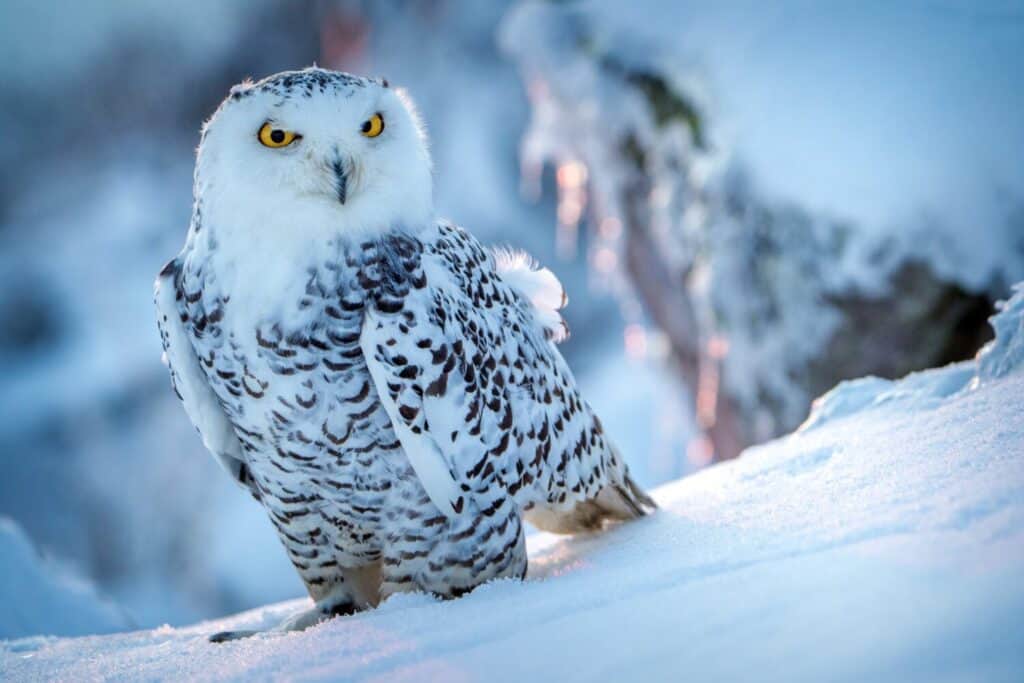
Although snowy owls have excellent eyesight, their prey often hides in burrows beneath the snow.
©jurra8/Shutterstock.com
The snowy owl is a large bird with a stunning and heavenly appearance. It is the only owl species in the world that is primarily white, allowing it to blend in with its Arctic and tundra habitats. Snowy owls have beautiful white feathers — especially the males. Female snowy owls are also white but also have more dark brown flecks on their feathers. Snowy owls are also one of the largest owl species and often hunt during the day rather than only at night. They depend on lemmings but can adapt to many other prey animals in the area as well.
3. Trumpeter Swan (Cygnus buccinator)
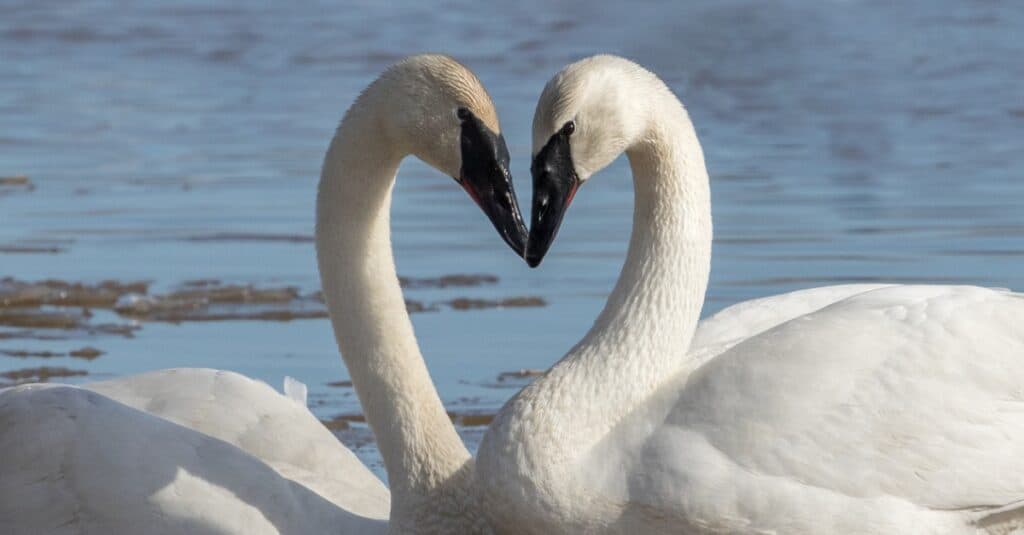
Trumpeter swans are the heaviest native birds in North America and can weigh up to 30 pounds!
©iStock.com/Dee Carpenter Photography
With its undeniably elegant appearance, the graceful trumpeter swan is the largest type of waterfowl in North America. It grows up to 6 feet long and has an impressive wingspan up to 10 feet wide! Trumpeter swans are pristine white, with a large black bill and a long and gracefully curved neck. They also have long, ballerina-like legs that are typically grayish-pink, yellowish-gray, or all-black. Trumpet swans get their name from their low-pitched, bugling call, which sounds similar to a trumpet. They tend to live in habitats near marshes, rivers, and lakes with dense vegetation.
4. Monarch Butterfly (Danaus plexippus)
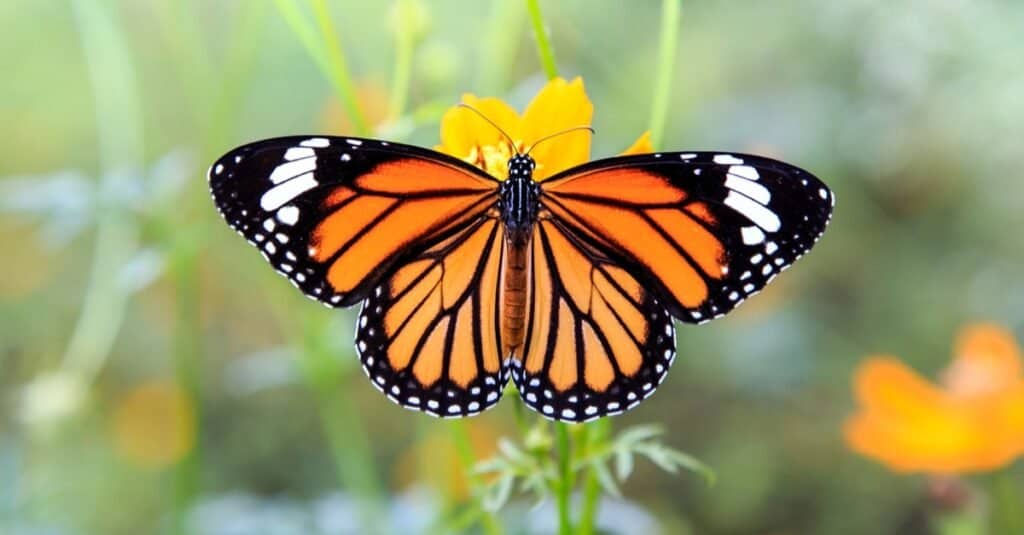
Monarch butterflies are some of the most recognizable butterflies in North America.
©CHAINFOTO24/Shutterstock.com
One of the smallest beautiful wild animals in Canada is the monarch butterfly. However, its small size is no less stunning, with bold orange, black, and white colored wings. Monarch butterflies have a wingspan of only 3 to 4 inches, but these tiny and delicate creatures undertake extraordinary migrations. Each fall, monarch butterflies traverse a remarkable distance of 2,400 to 3,100 miles from the verdant regions of Southern Ontario and Quebec to the majestic mountain forests of Mexico! Unfortunately, however, monarch butterflies are a fragile and endangered species, threatened by deforestation, climate change, and habitat loss along their migratory corridor.
5. Southern Resident Killer Whale (Orcinus orca)
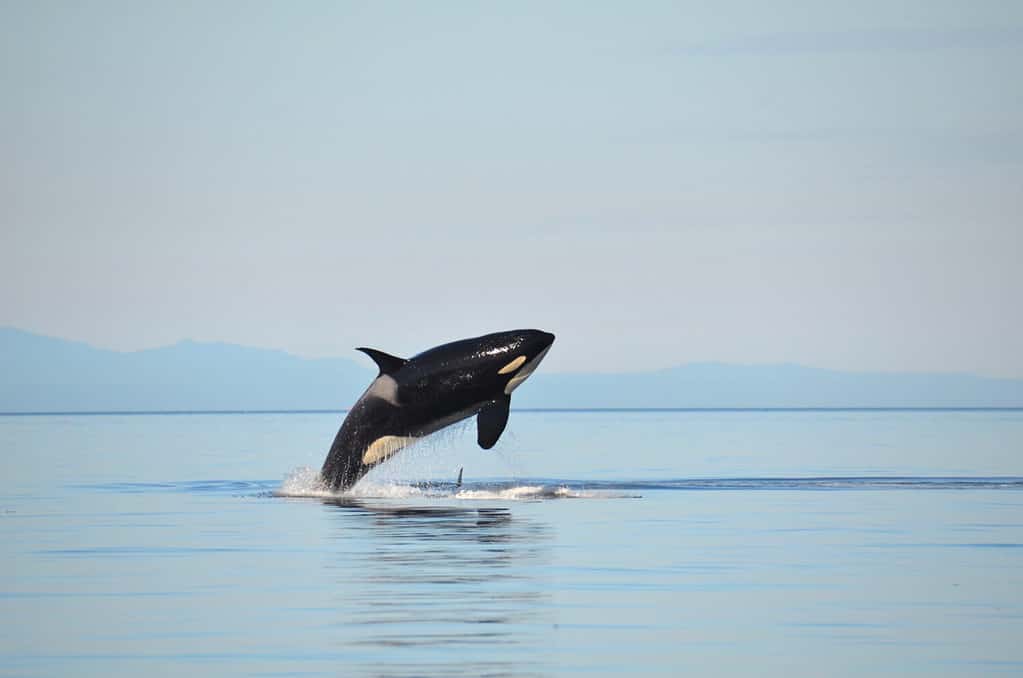
Southern resident killer whales live in the Salish Sea between Washington State and British Columbia.
©Monika Wieland Shields/Shutterstock.com
This very distinct population of killer whales or orcas lives in the Salish Sea of Canada’s British Columbia. Sadly, there are only just over 70 of these incredible animals left in the wild. Easily recognized by their stunning black and white patterns, the southern resident killer whales are unique in both their genetics and culture, consisting of three distinct pods: J, K, and L Pods. Like many other killer whale populations, the southern resident killer whales exclusively eat fish. They primarily feed on salmon and each whale eats 200 to 385 pounds each day! Another unique thing that sets these killer whales apart from other populations is that they actually hunt individually rather than as a pack. However, the whales still return to the pod and share their prey with their immediate family.
6. Canadian Lynx (Lynx canadensis)
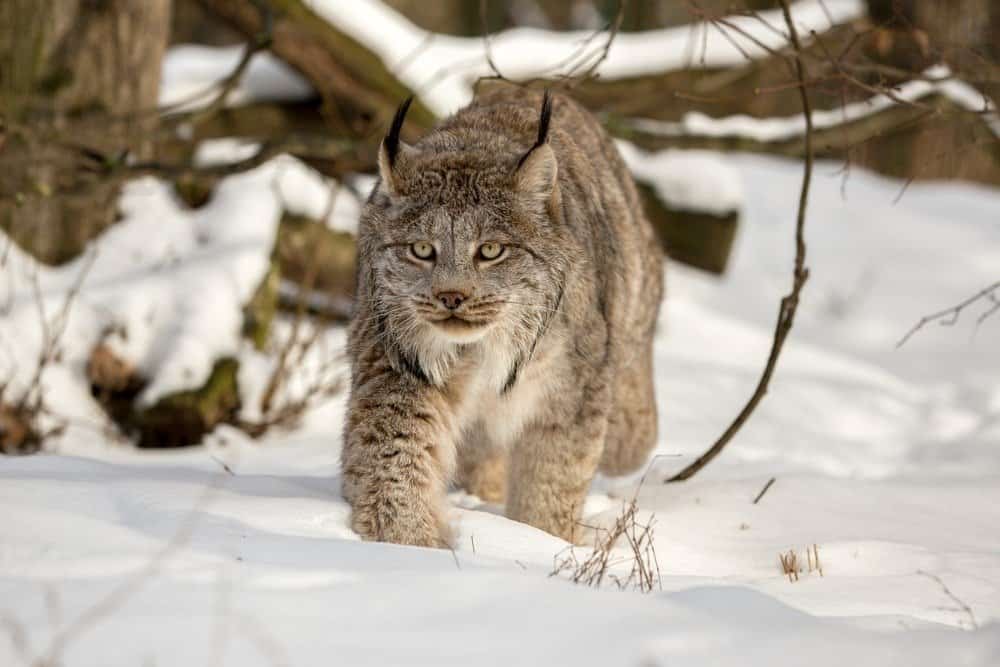
In addition to snowshoe hares, Canadian lynxes occasionally feed on young deer and ducks.
©Felineus/Shutterstock.com
Living within most of Canada’s thick taiga or boreal forests, the stunning Canadian lynx is an elusive feline who can spot prey from hundreds of feet away. These incredible hunters typically stand 19 to 22 inches tall at the shoulder and weigh 11 to 37 pounds. Their fur is long and dense, and they have tall, triangular-shaped ears with distinct black tufts at the ends. Canadian lynxes also have large paws that act like furry snowshoes, allowing them to stealthily sneak around on top of the snow. They are also excellent climbers and swimmers. Canadian lynxes are specialist predators and primarily eat snowshoe hares.
7. Polar Bear (Ursus maritimus)
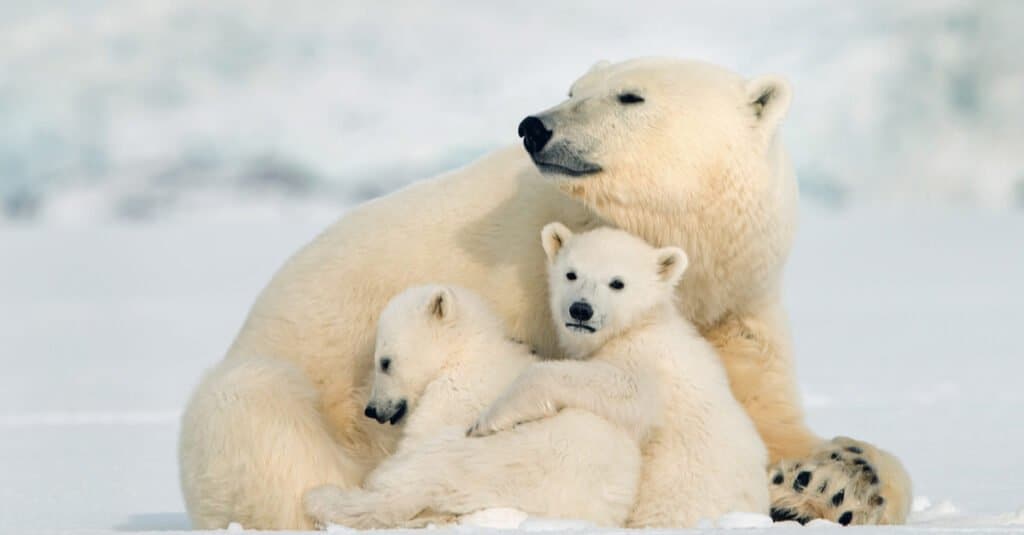
Polar bear cubs are very small when they’re born and stay by their mother’s side for several weeks.
©isabel kendzior/Shutterstock.com
One of the most iconic and beautiful animals in Canada is the majestic polar bear. In fact, about 60% of all polar bears in the world live in Canada! These enormous bears have thick white fur and live in Canada’s Arctic regions. Polar bears are the largest species of bear in the world, weighing an incredible 700 to 1,800 pounds! They are specialized predators and live both on land and on ice. They are excellent swimmers and typically prey on seals for their energy-rich blubber. However, although polar bears are extremely well-adapted to their Arctic habitats, they are a vulnerable species due to climate change, pollution, and other human activities.
8. Canadian Timber Wolf (Canis lupus occidentalis)

Canadian timber wolves are also called Mackenzie Valley wolves and northwestern wolves.
©Mircea Costina/Shutterstock.com
Weighing 66 to 155 pounds, the Canadian timber wolf is the largest subspecies of gray wolf in North America. With strong and graceful bodies, these beautiful animals grow 5 to 6 feet long, and sometimes even up to 7 feet! Canadian timber wolves live in Canada’s boreal forests, typically in packs of six to 12 led by an alpha male and female. Only the alpha pair breed, but the entire pack is extremely devoted and equally lends their support to raising the precious pups. Canadian timber wolves have gorgeous thick fur, ranging from tan to brown, gray, and white.
9. Caribou (Rangifer tarandus)
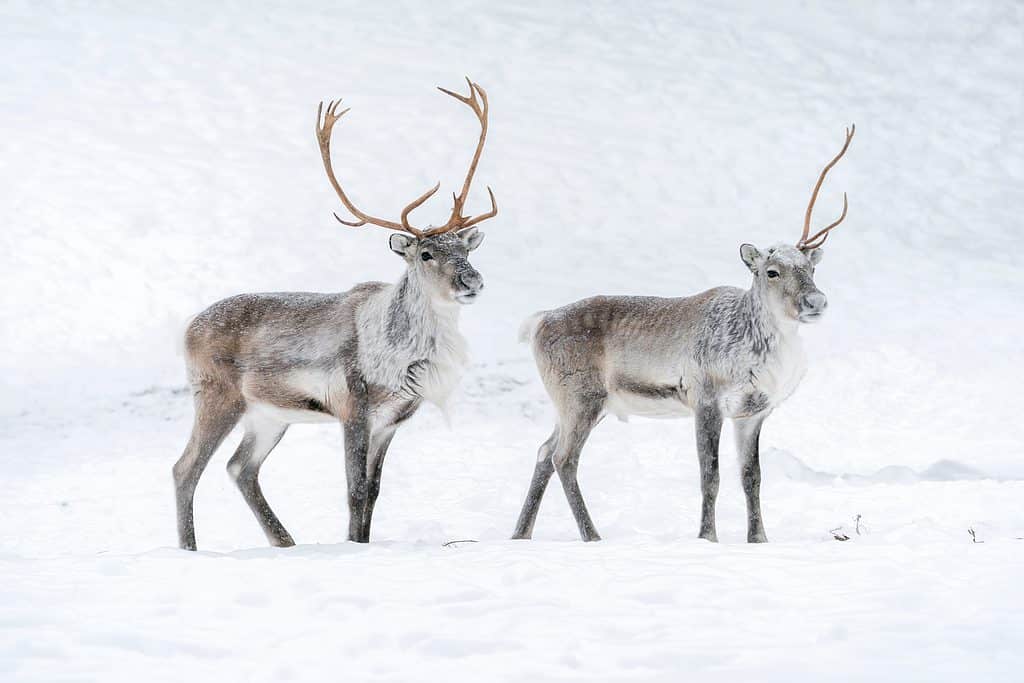
In North America,
reindeer
are also called caribou. Both the males and females grow antlers.
©Tam and Trace Photography/Shutterstock.com
One of the truly beautiful and majestic creatures living in Canada is the caribou. With long, shaggy coats and grandiose antlers, these beautiful wild animals move with both speed and grace across their frozen habitats. One of their most unique qualities, however, is that both male and female caribou have antlers! There are several subspecies of caribou in Canada living in various ranges and habitats. On average, they typically weigh 198 to 610 pounds, and each population has a slightly different appearance. In the woodland areas, Caribou are often a lush dark brown color in the summer, which lightens in the winter. On the other hand, many of the caribou herds living in the tundra have coats that are almost completely white.
10. Snow Bunting (Plectrophenax nivalis)
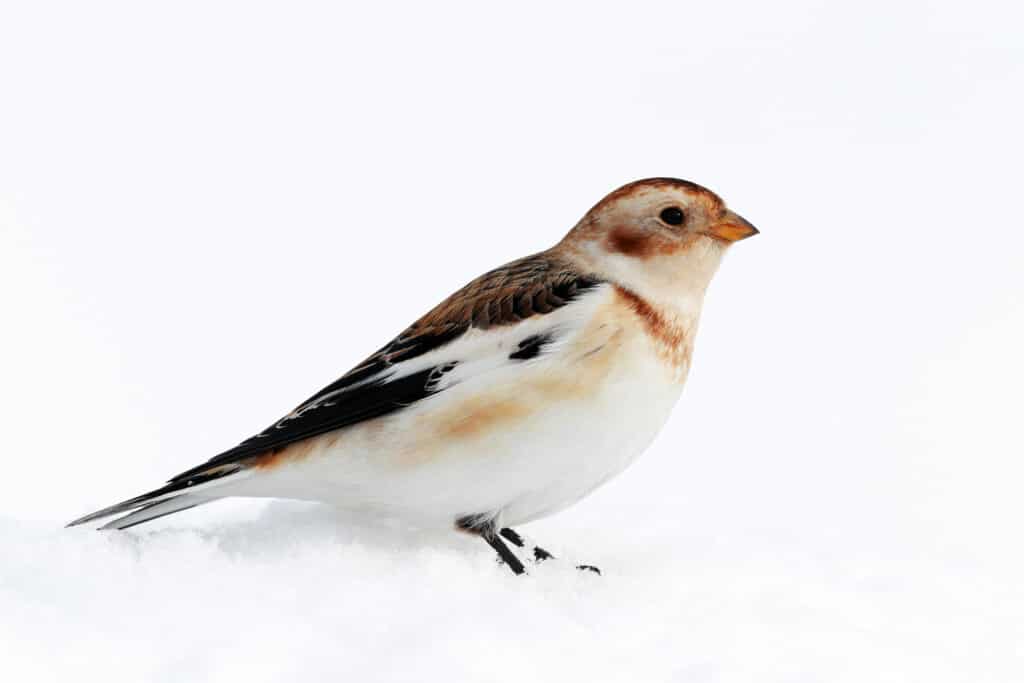
Snow buntings are migratory birds and breed in Arctic regions.
©Mark Medcalf/Shutterstock.com
Another beautiful wild animal in the Arctic expanse of Canada is the snow bunting. In Arctic regions, snow buntings are a sign of spring, as they return here after their annual migration. These small songbirds are only about 5 to 6 inches long, with beautiful snowy white feathers, a black and white tail, and black wingtips. Snow buntings often gather in large flocks, swirling through the air like a winter storm — so many people also call them snowflakes! However, they are ground-dwelling birds and typically walk along the icy terrain. When it is not breeding season, snow buntings also have additional brown or rusty patches on their bodies.
11. Musk Ox (Ovibos moschatus)
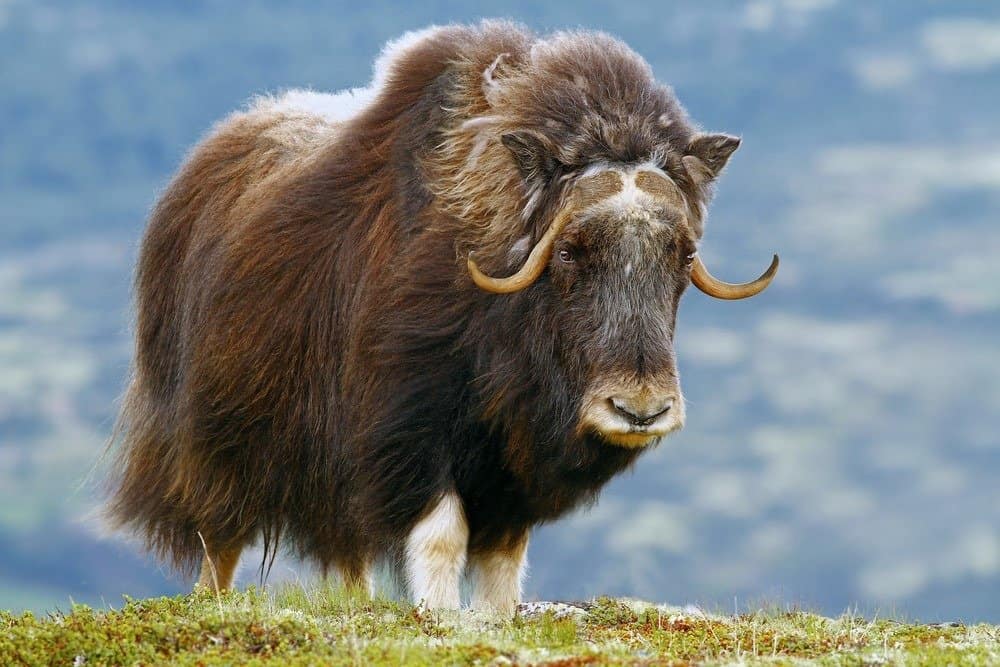
Musk oxen get their name from the strong, musky odor of males during their seasonal rut.
©Martin Hejzlar/Shutterstock.com
One of the largest wild animals in Canada is the beautiful musk ox. A large, hoofed mammal, musk oxen have luxurious shaggy hair and majestically curled horns. Although they may look like oxen, they are actually more closely related to mountain goats! Their thick, dark fur reaches almost all the way down to their feet and helps to keep the animals warm against freezing temperatures. Occasionally, some people even use musk oxen wool to make yarn and fabrics. In fact, this naturally collected wool is not only warm and strong, but it is even softer than cashmere! Musk oxen are impressive animals that grow from 3.5 feet to nearly 5 feet tall at the shoulder and weigh 400 to 900 pounds.
12. Canada Jay (Perisoreus canadensis)
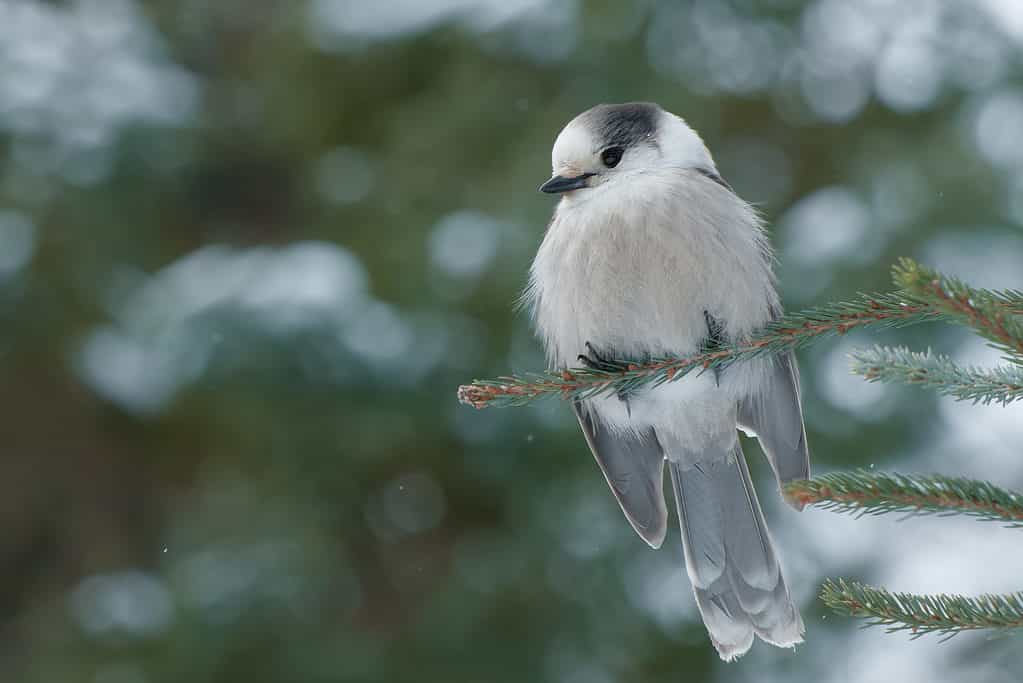
Many see the Canada jay as a sign of good luck, a warning of danger, and a wise teacher.
©Paul Reeves Photography/Shutterstock.com
The Canada jay is a beautiful songbird that lives in the boreal forests of Canada. Measuring around 10 to 13 inches long, Canada jays have delicate gray feathers on their backs with lighter gray on their bellies. Their white heads also have a darker gray or black patch on the nape, and their long tails are gray with lighter-colored tips. They are intelligent and curious creatures who adapt well to human areas. Canada jays are a beloved symbol of Canada. Some of the First Nations tribes call these beautiful birds Wisakedjak, or “whisky jacks”, named for the trickster hero in many of their legends. The Mi’kmaq of Nova Scotia believe that each of the seven stars in the Big Dipper represents a different bird, and one of them is the Canada jay, known as Mikjaqoqwej.
13. Ermine or Stoat (Mustela erminea)
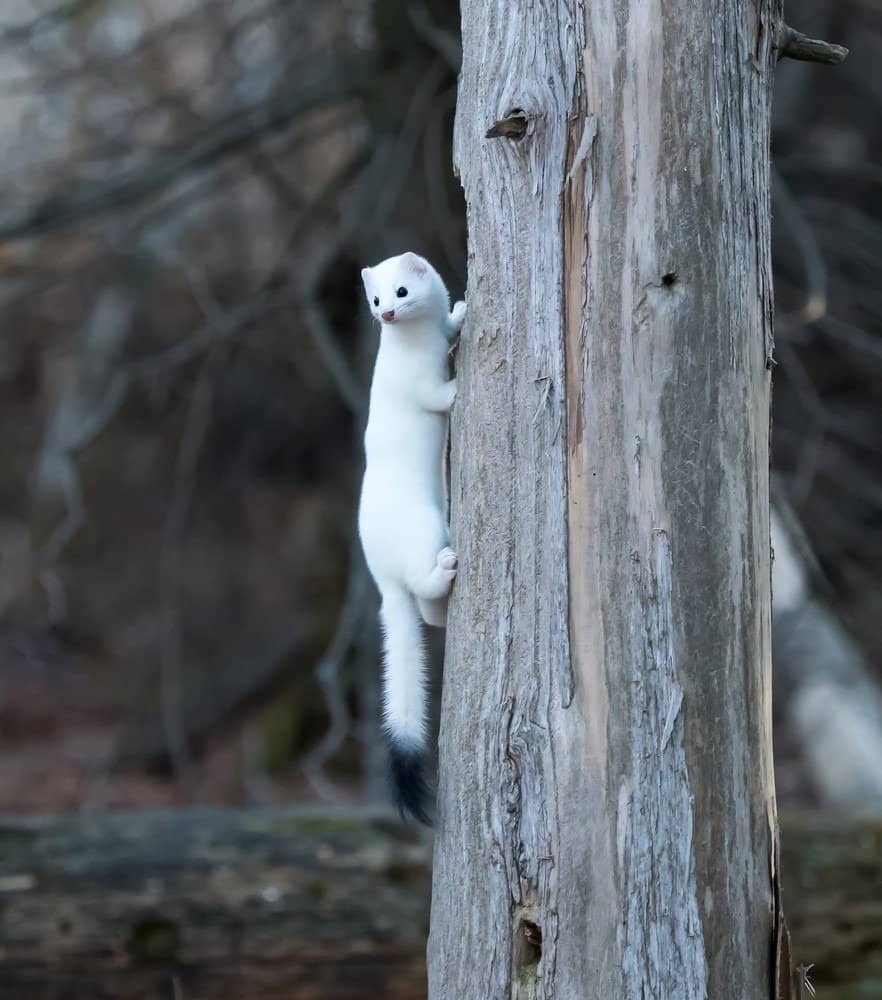
Ermines are members of the weasel family and eat birds, eggs, small mammals, and frogs.
©FotoRequest/Shutterstock.com
These small and carnivorous creatures live in tundra habitats in Canada. Stoats have long, slender bodies covered in dense brown fur that transforms into sparkling white during the winter. Their long white tails are also tipped in inky black, matching their gleaming black eyes. During the winter, many people call these beautiful wild animals in Canada ermines rather than stoats, which refers back to Medieval Europe when their fur coats were used as a symbol of royalty. In addition to their elegant appearance, ermines are active and agile animals, and can gracefully climb trees and swim with ease across long distances.
14. Arctic Hare (Lepus arcticus)
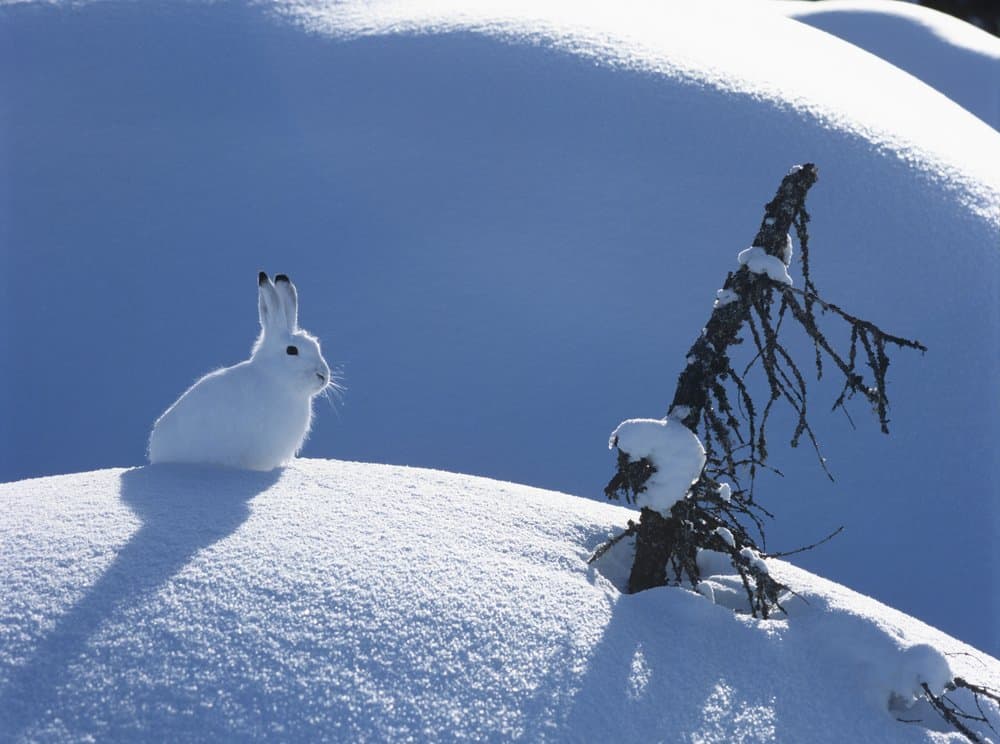
Arctic hares can run up to 40 miles per hour and sometimes dig under the snow where they snuggle together to keep warm.
©sirtravelalot/Shutterstock.com
Another beautifully white wild animal in Canada is the Arctic hare. Arctic hares are one of the largest types of lagomorphs (rabbits, hares, and pikas), ranging from 17 to 20 inches long and weighing 6 to 15 pounds. They live in the icy Arctic tundra, and their bodies are well-adapted to the cold. Compared to other rabbits and hares, Arctic hares have much shorter legs and ears, allowing them to retain warmth throughout their bodies. During the winter, Arctic hares also have a thick coat of beautiful white fur, dark eyes, and a small nose that gives them a startlingly beautiful appearance.
15. Atlantic Puffin (Fratercula arctica)
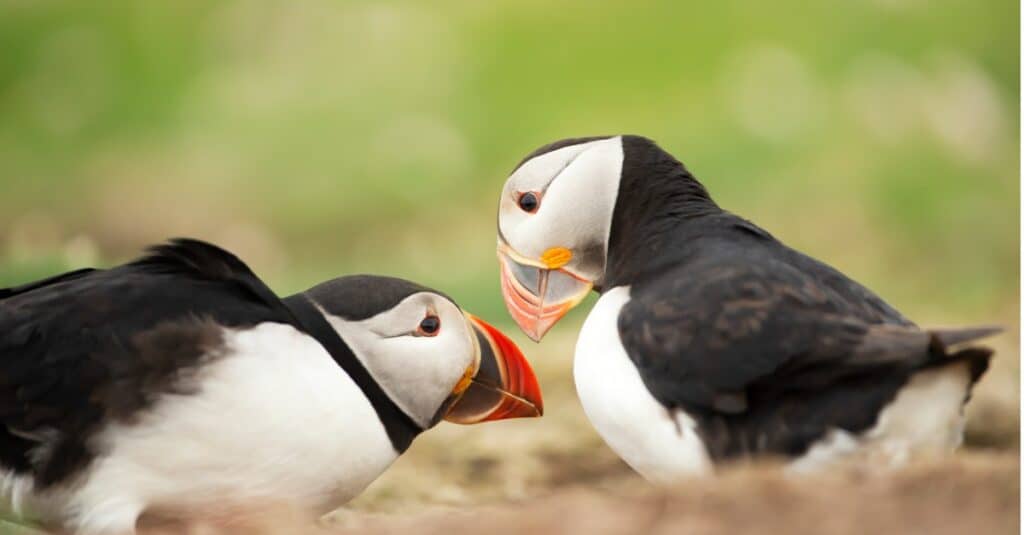
Atlantic puffin mates strengthen their bond by billing or rattling their beaks together.
©Giedriius/Shutterstock.com
Another beautiful wild animal that lives in the oceans surrounding Canada is the Atlantic puffin. These beautiful birds are excellent swimmers and spend a great deal of their time in the water where they forage for fish. Atlantic puffins are extraordinary divers, and sometimes dive up to 200 feet below the surface in search of food! They are the only puffin species native to the Atlantic Ocean, measuring around 12 inches long. Their black and white bodies are beautifully contrasted by their large and colorful bills, which are covered with bright yellow and red patterns. These brilliantly colored bills have caused some to call puffins “sea parrots”.
16. North American Cougar (Puma concolor couguar)
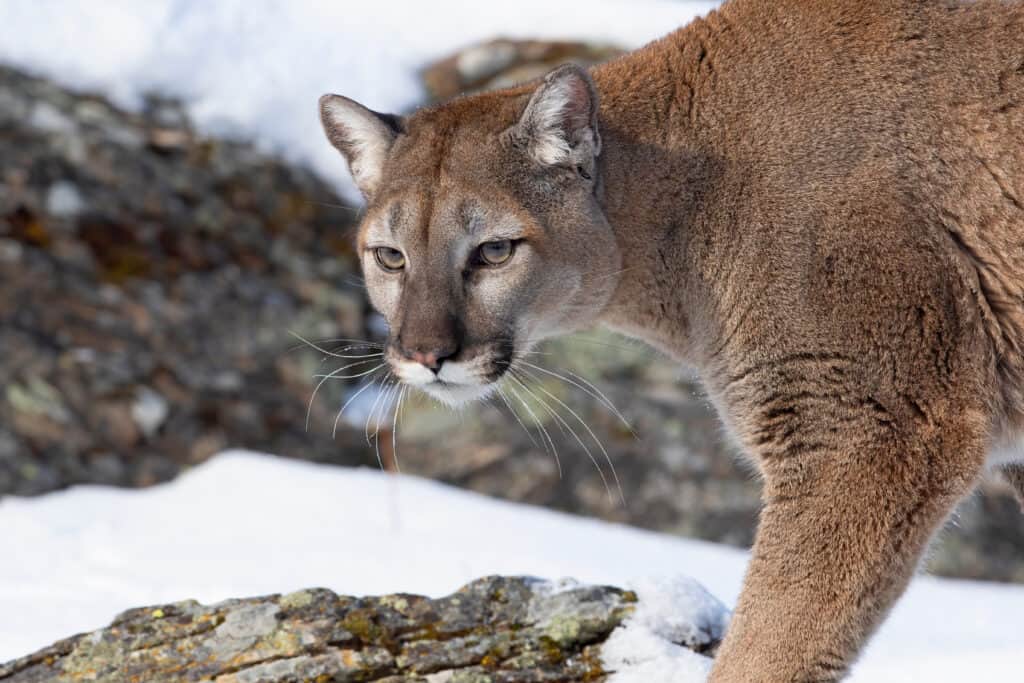
In some regions of Canada, the North American cougar is considered a threatened species.
©Jim Cumming/Shutterstock.com
Living within the Rocky Mountain region of Canada, the North American cougar is a majestic and beautiful big cat. Northern American cougars have long and slender bodies covered in plush, tan-colored fur. They grow 6.5 to 8 feet long and weigh 120 to 200 pounds. As powerful apex predators, cougars are at the top of the food chain, preying on all kinds of different animals from bighorn sheep to rabbits, deer, rodents, elk, and even carrion. They are graceful and skilled hunters who can climb trees and swim with style. North American Cougars are protected, and it is illegal to hunt them in Canada.
17. American Black Bear (Ursus americanus)

American black bears typically live in forested areas but will often venture out to find food.
©Mark Caunt/Shutterstock.com
The smallest species of bear in North America is the American black bear, which grows around 5 to 8 feet long and weighs 100 to 600 pounds. And despite its name, not every black bear is actually black! Most black bears are actually, often with a white chest patch, but there are some that have blonde, brown, blue-gray, and cinnamon fur as well. Black bears are muscular animals with plush fur and small rounded ears. In addition, American black bears also have large, soulful eyes and intelligent expressions. And even though they are powerful and majestic, and intelligent, they also love to play and have fun!
18. North American Beaver (Castor canadensis)

The North American beaver is one of the largest rodents in the world, second only to the
capybara
!
©Frank Fichtmueller/Shutterstock.com
An official emblem of Canada, the beaver is one of the most beautiful animals in the country. They have thick, water-resistant fur coats that are a luscious chocolate brown color, which were highly coveted in the fashion world for many years. In fact, beavers were nearly hunted to extinction in North America for their fur! Beavers are the largest rodent in North America, weighing 25 to 70 pounds. They are semi-aquatic animals with large webbed hind feet and massive paddle-shaped tails that help them navigate the water with ease.
19. Canada Goose (Branta canadensis)
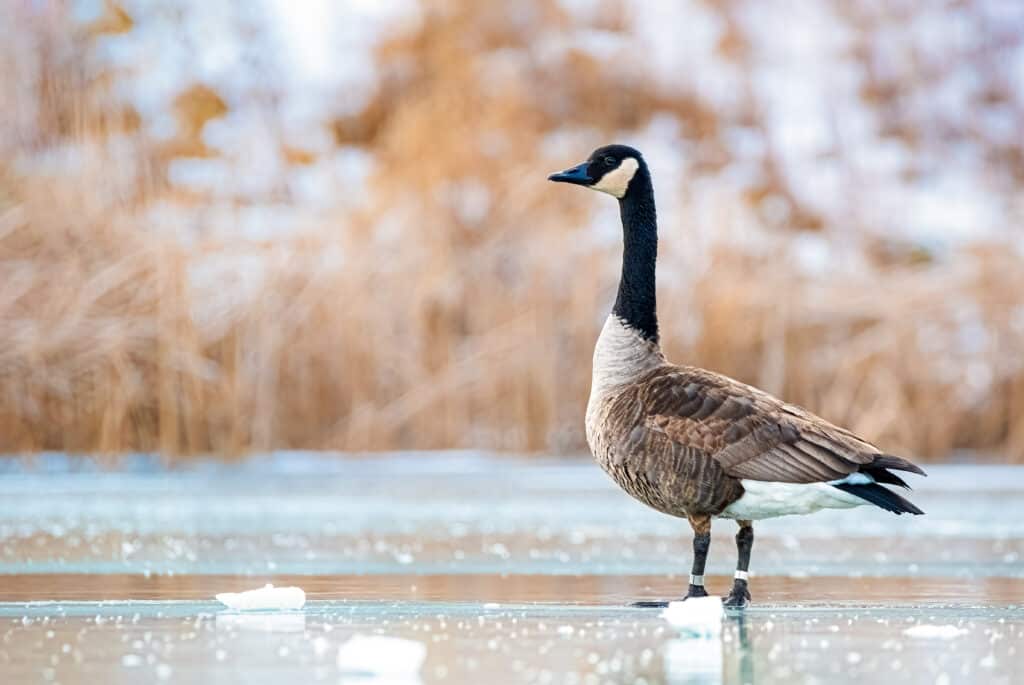
Canada geese are monogamous, and both parents help to care for and raise their young.
©Rogney Piedra Arencibia/Shutterstock.com
Also called the Canadian goose, this beautiful bird lives in the Arctic and temperate regions of North America. These beautiful wild animals are migratory birds and travel to Canada to breed. Like the Canada jay, Canada geese are very adaptable birds who have learned to live alongside humans and in human-altered areas with ease. Canada geese grow 29 to 36 inches long on average, with slender grayish-brown bodies. Their long necks and small heads are black, accented with a white chinstrap. They are social animals and gather in large flocks, commonly honking and quacking loudly to one another. Canada geese typically fly together in an elegant V-formation and migrate between 2,000 to 3,000 miles each year.
20. Moose (Alces alces)

Although they are the largest deer species on earth today, moose are surprisingly good swimmers!
©ArtBBNV/Shutterstock.com
Large and majestic, the moose is another beautiful and iconic land animal in Canada. Moose have massive antlers that can grow up to 6 feet wide, and are the heaviest deer species on earth, weighing 440 to 1,500 pounds! However, unlike other species of deer, moose are typically solitary and do not live in herds. In Canada, these beautiful wild animals often live in boreal forests and meadows where they graze on leaves and grass. Moose can grow up to 6.5 feet tall at the shoulder, with brown, black, or reddish-brown fur.
Summary of the 20 Most Beautiful Wild Animals in Canada
| Common Name | Scientific Name | |
|---|---|---|
| 1. | Arctic Fox | Vulpes lagopus |
| 2. | Snowy Owl | Bubo scandiacus |
| 3. | Trumpeter Swan | Cygnus buccinator |
| 4. | Monarch Butterfly | Danaus plexippus |
| 5. | Southern Resident Killer Whale | Orcinus orca |
| 6. | Canadian Lynx | Lynx canadensis |
| 7. | Polar Bear | Ursus maritimus |
| 8. | Canadian Timber Wolf | Canis lupus occidentalis |
| 9. | Caribou | Rangifer tarandus |
| 10. | Snow Bunting | Plectrophenax nivalis |
| 11. | Musk Ox | Ovibos moschatus |
| 12. | Canada Jay | Perisoreus canadensis |
| 13. | Ermine or Stoat | Mustela erminea |
| 14. | Arctic Hare | Lepus arcticus |
| 15. | Atlantic Puffin | Fratercula arctica |
| 16. | North American Cougar | Puma concolor couguar |
| 17. | American Black Bear | Ursus americanus |
| 18. | North American Beaver | Castor canadensis |
| 19. | Canada Goose | Branta canadensis |
| 20. | Moose | Alces alces |
The photo featured at the top of this post is © Paul Loewen/Shutterstock.com
Thank you for reading! Have some feedback for us? Contact the AZ Animals editorial team.







